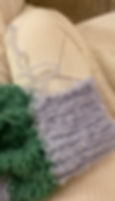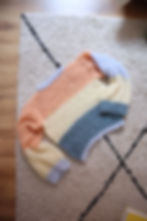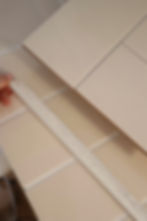juppp not one old teddy jacket is safe near me
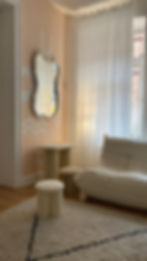
need:
an old teddy jacket or coat or teddy fabric
padding or foam
cardboard tubes or as an alternative plastic tubes or wooden pillars
double sided tape
upholstery stapler or staple gun
a piece of wood for the top
jigsaw to cut the legs and the top
scissors and pen
screws or super strong glue
Version one: the glued on leggedie legs and new fabric

measure your legs and cut them your desired length. I wet with about 40 cm for a super low mini stool and 80 cm for a bench.
decide on how many legs you want, can be three as a cluster or four when you're about to make a bench.

plan your top accordingly so your legs match the size of the seating area.
for the small stools I wet with a super tight snug fit to have it over all rather short and small, and not a huge overlap.

take your double sided tape and tape the whole surface of the legs.
you can do super close tape next to tape or leave 2-4 cm in between tape strips.
but surely do enough so you don't get warped hanging down fur after a while.

once you've peeled away the film of the tape place the leg onto your fabric.
try to place the edge in the middle of a piece of tape so both ends of the teddy fabric meet in the middle of a piece of tape.
this way you don't have loose bits flopping around.

cut the excess fur on the side thats going to meet the seating to have a clean surface to put glue on

for the bottom (the part thats stands on the floor) you can do the same and cut it flush with the tube,
or you can wrap the bottom and stick it into your tube - if you use a full wood pillar I would just cut it like the top

once you have your fur covered legs its time to do the seat

cut your wood with a jigsaw

once you've cut your wood cut your padding as well. I use super thick 4 cm quilt padding, and sometimes I do two layers of it
you can use the double sided tape to stop it from sliding around during the next step

cut a piece of your teddy fur big enough to wrap around the edges easily.
mark where your legs will sit.
the drill holes are another option to assemble. if you want to screw your legs onto the top, drill holes like on the picture and screw trough the top into the legs before you glue on the padding. (pictures are further down with the other stool)

start to staple the fur onto the back of the wood. keep an eye on the markings of where the legs go and make sure you don't staple on top of the markings.
you can pull slightly to get a smooth circle, but don't pull too much before you've secured the fabric all around, you might drag the padding across the wood other wise.
easiest is to set 6 staples in a star pattern around the whole circle and then start to pull the rest tight and snug.

cut away the excess fur to have a clean look.
Ive covered the wood as much as I could in between the legs to get a over all fur look, but you can leave party of the wood showing, since the stool is so low no-one is going to see it anyways.
ok .... motivation took over and I forgot to take pics of the glue part, but basically I smeared super strong glue across the markings and the rim of the tubes and placed the legs onto the wood. I put heavy books on top to really press the pieces together and let them dry over night. if you use wood pillars you can do the same thing and just smear the whole top of the pillar in glue. if your cardboard tubes are a little thinner (don't use the inside of kitchen towels haha they have to be somewhat stable to work as furniture) it still will be pretty easy to glue as log as you got a smooth rim at your cardboard tube. since the cardboard will soak up some of the glue make sure you use more than you think.

tipps for sourcing cardboard tubes of any kinds: I get mine from a factory near by my house. they use big rolls of cling film to wrap their products when they get shipped, the tubes are what's inside of the huge cling film rolls. so I just stop by and get the tubes, cause they are just landing in their trash cans anyways. you can ask at your local hardware store, they do have sort of the same tubes to store ropes on and stuff, also generally checking out the trash where some kind of packing and unpacking happens is an option. lastly you can get cardboard tubes to ship and store posters and such, thats also an option. just make sure they have somewhat of stability in itself.
Version two: screwed on legs and recycling old teddy garments

you will need legs, a top piece of wood and some padding as before and some kind of old teddy piece of clothing.
ideally with kinda big panels of fabric, but well make it work

first you gotta cut apart the jacket or coat. ideally you cut super close to the seams to get big pieces.
cut into the inner fabric covering to revea the seams of the outer fabric and cut along the seams. get rid of buttons and such
when picking your piece of clothing you kinda have to check if there will be enough for your piece of furniture. in my case one front panel was the same width as my legs were long so I knew I could at least make two legs just with the front panels.

same thing as before cover the legs with tape and then with the fur.
keep all excess cuttings!

cut straight and super close to the other side of the fabric. as mentioned above, try to start and end the wrapping in the middle of one strip of paint to have the loose edge completely glued down

try to meet the edges and blend the cut with the fur ( its gonna be hidden anyways cause you can place the seams facing inwards when attaching the legs)

thats one leg done with the seam up front on the right

I ended up not having one long enough strip of fabric for the third leg, so I just glued the leftovers from the first two together, as before just make sure all raw edges are glued dow and cut super close to each other

so thats my leg with two seams
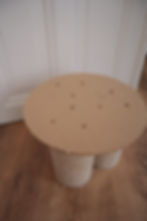
next I screwed the legs onto the top board from the top. so if you put on the padding the screws are hidden and everything looks tidy and cute

place your padding on top and staple away.

I ended up using a sleeve for the top part, with had a side seam, but its not really that visible.
when stapling I just tried to put the staples as close as possible to the legs and cut around the legs to get rid of the excess flaps










